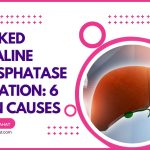3 Common Gallbladder Sepsis Symptoms.
Our content is not intended nor recommended as a substitute for medical advice by your doctor. Use for informational purposes only.
Your gallbladder is a small sac-like organ attached to the liver. The most common gallbladder disease is stone formation inside the gallbladder cavity.
Often, patients with gallstones experience biliary colics that come and go due to the presence of the stones (without infection).
Eventually, these gallstones may obstruct the gallbladder’s opening (or the cystic duct), predisposing bile build-up inside the gallbladder and infection.
As a result, the bile inside the gallbladder becomes infected and causes severe inflammation (acute cholecystitis).
In this article, you will learn the differences between:
- Symptoms of uncomplicated biliary colics.
- Acute cholecystitis (gallbladder infection).
- Systemic symptoms of gallbladder sepsis.
1. What is gallbladder sepsis?
The definition of sepsis:
Sepsis is different from an infection. Sepsis is defined as a life-threatening organ dysfunction caused by an abnormal response of your body to infection (reference).
Unlike an infection, sepsis effects are beyond the affected organ. For example, in the case of gallbladder sepsis, the symptoms may involve other organs such as the cardiovascular system, the respiratory system, and the kidney.
Sepsis can cause shut down of multiple body organs with high mortality rates.
Who are at higher risk of gallbladder sepsis (reference):
- Older patients.
- Patients with complicated acute cholecystitis (gallbladder gangrene, perforation, or abscess.
- Pregnant or recently pregnant women.
- Patients with diabetes mellitus.
- Patients in intensive care units.
- People with chronic organ dysfunction such as liver cirrhosis and chronic kidney diseases.
Gallbladder infection V.S. Gallbladder sepsis:
Gallbladder sepsis is different from a gallbladder infection. Gallbladder infection is confined to the gallbladder (called uncomplicated acute cholecystitis).
While sepsis is an aberrant body response to a gallbladder infection, in such cases, gallbladder sepsis may cause life-threatening complications such as septic shock (low blood pressure), respiratory failure, or kidney failure.
The most common cause of gallbladder sepsis is complicated cholecystitis (gangrene, perforation, or abscess) in high-risk individuals (such as the elderly and those with D.M.).
2. Gallbladder sepsis symptoms:
The symptom of gallbladder sepsis is a combination of gallbladder-specific symptoms, systemic sepsis symptoms, and others.
The main categories of symptoms of gallbladder sepsis include:
- Symptoms of acute cholecystitis.
- Symptoms of sepsis (multi-system).
- Other gallstone-related conditions that cause sepsis (cholangitis and gallstone pancreatitis)
A. Symptoms of acute cholecystitis.
Acute cholecystitis is an episode of infection and inflammation of the gallbladder. Acute cholecystitis is a different form of biliary colics that occurs now and then without inflammation or sepsis (uncomplicated gallstone disease).
The symptoms of acute cholecystitis include:
- Acute severe right upper quadrant pain may radiate to the back, the right shoulder, and the epigastric area.
- Unlike the attack is often prolonged (more than 6 hours), more severe.
- Severe nausea and vomiting.
- Associated with fever.
- Anorexia (loss of appetite).
The table below summarizes the differences between uncomplicated gallstone disease and acute cholecystitis regarding the symptoms.
Typical (uncomplicated) gallbladder pain | Acute cholecystitis & its complications | |
| 1. Site | Usually, The right upper quadrant of your abdomen. | The same. |
| 2. Spread | – The pain may spread to the back of the right shoulder. – Also, it spreads to the epigastric area. | The same. |
| 3. Character | Constant. builds up then disappears gradually. | The same, but more severe and more prolonged. |
| 4. Duration | At least 30 minutes. It may last up to 6 hours. | It can last more than 6 hours. |
| 5. Relation to food | – Triggered by foods (especially fatty food and large meals. – However, it can start spontaneously. | Often persistent. Regardless of eating. |
| 6. Comes and goes? | Yes | No |
| 7. Nausea, vomiting. | Often Present. | Present, but very severe and persistent. |
| 8. Associated symptoms | – Heartburn and chest pain. – Bloating, fullness. – Early satiety. – Epigastric pain. | The same, but more severe. |
| 9. Fever. | Absent. | – Often present. – it is more frequent and severe in complicated cholecystitis |
| 10. Jaundice | Absent | Present if there are Bile duct stones. |
| 11. Murphy’s sign (tenderness over the gallbladder area) | Often absent. | – Often present in uncomplicated acute cholecystitis. – It may be absent in complicated (gangrene or perforation) cholecystitis. |
B. Sepsis symptoms.
The symptoms of gallbladder-related sepsis range from mild symptoms such as shortness of breath, fever, body aches, and dizziness to severe symptoms of organ damage such as respiratory failure, kidney shutdown (absent urine), coma, etc.
Sepsis passes into stages according to its severity.
1. Early Sepsis symptoms:
- Fever.
- Fast heartbeats.
- Headache, dizziness, mild confusion.
- Mild shortness of breath.
2. Sepsis (multiorgan affection) symptoms:
- Respiratory symptoms: severe shortness of breath, rapid respiration, and low oxygen levels.
- Cardiovascular: chest pain, shortness of breath, fast heartbeats, low blood pressure, inability to lie flat in bed.
- Brain: confusion, dizziness, lethargy, or coma.
- Kidneys: peeing little urine, shortness of breath (due to fluid and acid build-up in your body).
- The liver: jaundice (yellowish skin and eye whites), dark urine, and maybe clay stool.
- Blood (low platelet): easy bruising and bleeding.
3. Septic shock symptoms:
If left untreated, the gallbladder sepsis may progress into a more severe form of sepsis called septic shock.
The extreme body response to gallbladder infection causes your blood vessels to dilate and lose their tone.
As a result, the blood pressure falls significantly, leading to shock (septic shock).
C. Other symptoms of gallstone-related conditions that may lead to sepsis
- Acute cholangitis.
Acute cholangitis often occurs when a gallstone slips into the common bile duct and causes stasis and infection of the bile ducts. The main symptoms include jaundice, fever, and right upper quadrant pain. Severe cases may develop hypotension (shock) and altered consciousness. - Gallstone pancreatitis:
Small gallstones may slip to the pancreas and obstruct its duct, resulting in acute pancreatitis. Learn more.
3. Can an infected gallbladder be fatal?
Infected gallbladder (acute cholecystitis) can lead to fatal complications such as sepsis and multiorgan failure. However, the mortality rate is often low (about 3%).
The mortality rate increases significantly with complicated gallbladder infections such as:
- Gallbladder abscess.
- Gallbladder gangnrene.
- Gallbladder perforation.
- Gallbladder-related periotnitis.
Also, the mortality rate is higher in older patients and those with co-existing chronic conditions such as diabetes mellitus.
4. What causes gallbladder sepsis?
Gallbladder infection is different from sepsis. Infection of the gallbladder (acute cholecystitis) results from a gallstone obstructing the gallbladder’s opening, leading to stasis of the bile and infection.
Most causes of gallbladder infection (acute cholecystitis) don’t lead to significant sepsis or septic shock).
In certain cases, sepsis from the gallbladder occurs due to either:
A. Local complications of acute cholecystitis
- Access.
- Gangrene (necrosis of its wall).
- Perforation (bursting) of the gallbladder.
- Diffuse inflammation of the peritoneal cavity due to perforation (rare, local abscess around the gallbladder is more common).
B. Patient weak immune system
- Diabetes.
- HIV.
- People who take immune-suppressive medications.
- Older age (also due to poor blood vessel health).
These high-risk groups can develop sepsis and septic shock without significant local complications of acute cholecystitis.
- Evidence-based
- Written by a doctor.

Related Posts:
- Unexplained Diarrhea & No Other Symptoms: 9 Common Causes.
- Can Gallbladder Pain Affect your Back Only?…
- 6 Causes of Bigger Stomach after Gallbladder Surgery…
- 6 Colon Cancer Symptoms in Women: Doctor Explains.
- Safest Gallbladder Diet after Surgery (with 60+ Recipes)
- 6 Problems After Gallbladder Removal, Years Later…





